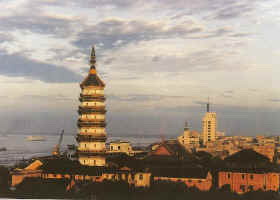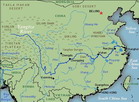2020 Yangtze River Cruise and Ferry Starting from 79 USD p.p.!
Anqing
The city of Anqing, on the north
bank, is situated in that area of Anhui Province:
called Huainan, meaning south of the Huai River.
It is built along the Dalong Hills amidst pretty
surroundings. Historical records refer to the
appointment of an official to the town as early
as  the Spring and Autumn period (770--476 BC).
During the Qing(l644--l911) and the Republican
period (l911--49) the city was the capital of
province, though today the capital is Hefei,
further north. Anqing's main function is to
gather and distribute local produce: it also
has a petrochemical industry.
the Spring and Autumn period (770--476 BC).
During the Qing(l644--l911) and the Republican
period (l911--49) the city was the capital of
province, though today the capital is Hefei,
further north. Anqing's main function is to
gather and distribute local produce: it also
has a petrochemical industry.
The handsome octagonal Zhenfeng
Pagoda,the major landmark,was built in 1570
amidst the remains of the Song-dynasty Welcoming
the River Temple(Yingjiang Si). A fine view
of the city can be enjoyed from its top storey.
The pagoda was built by a Daoist
(Taoist) architect, Zhang Wencai, who was ought
to Anqing specially from Baiyun Temple in Bejing.
Stone balconies surround six of its seven storeys.
Inside, over 600 Buddha images cover the brick
walls. Set into the lower half of the pagoda
are images of the pagoda are images of the local
prefect, Wang Erquan, who commissioned its construction,
and other personages of the period.
The town was occupied by the Taiping
rebels for six years, and one of its kings7;built
a residence here. It seems that the imperial
defences of Anqing left much to be desired,
for when it fell to the rebels in 1853 Emperor
Xianfeng wrote:'Great has been my indignation
on reading the memorial... how could that important
provincial Capital be captured by the bandits
in one day?' The city, retaken in 1861, was
ravaged.Travellers to the city 60 years later
noted that large parts of it were still in ruins.
Riverboats stop at Guichi (at the
mouth of the Qiupu River), which is the closest
port for those visiting the sacred Buddhist
mountain of Jiuhua and the famous scenic area
of Huangshan to the south. These can be reached
by bus, although Wuhu,further downriver, offers
more choice of transport.



